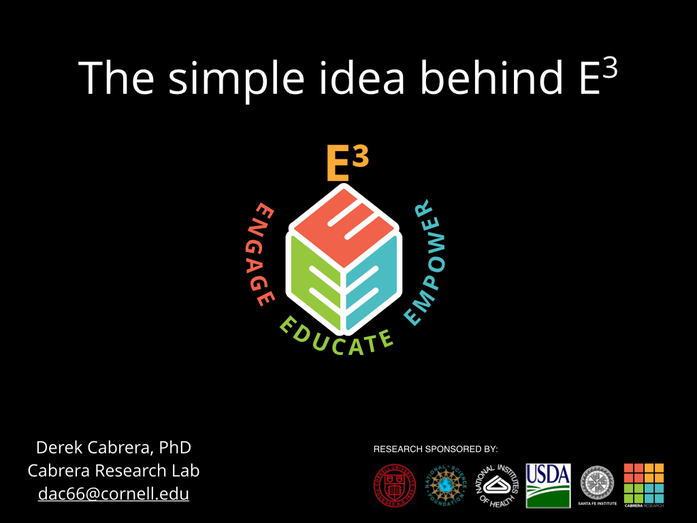Dr. Cabrera's 2015 ISSS Plenary Talk
 Derek & Laura Cabrera
·
18 minute read
Derek & Laura Cabrera
·
18 minute read
Dr. Cabrera's plenary at ISSS (the 58th Meeting of the International Society for the Systems Sciences at the School of Business at George Washington University, Washington DC) on the universality of systems thinking 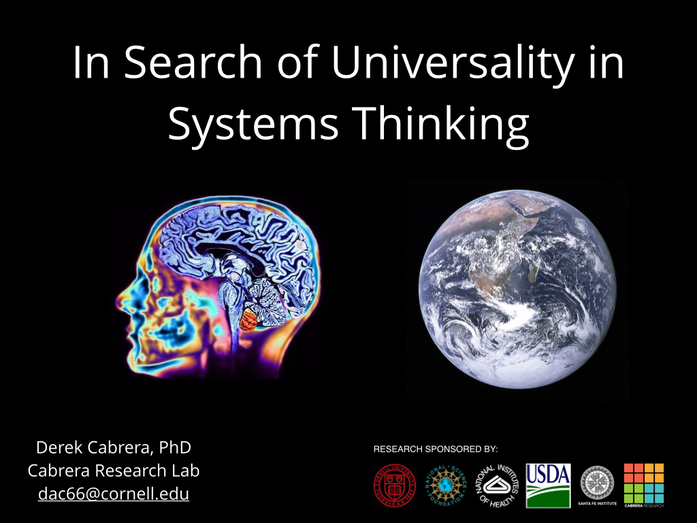
Please use the following citation: Cabrera, D. (2014) In Search of Universality in Systems Thinking. Plenary for 58th Meeting of the International Society for the Systems Sciences at the School of Business at George Washington University, Washington DC. http://www.cabreraresearch.org/blogs/dr-derek-cabrera-s-plenary-for-58th-meeting-of-the-internationa...
In Search of Universality in Systems Thinking
I want to take this opportunity to challenge those of us who have gathered here to advance our understanding, and the world’s understanding of systems thinking. I think we’ve gotten ahead of ourselves. I think we need to revisit the most basic of our roots and ask the simplest of questions… I hope you will entertain with me, this critical look at ourselves and hold ourselves and our discipline, which I love, to an even higher standard than our good work thus far has met.
I especially want to challenge those of us that I would call systems theorists. Those lucky or unlucky few, depending on who you ask, who do theory. Who have a responsibility to inform the world, many of whom are in this room.
I have never believed that theory and practice were separate. So, I want to ask both a theoretical and a practical question. It is the question I am most often asked when I am out in the world. It’s what people want to know about systems thinking. It is the question asked by scholars and parents, students and teachers, CEOs and carpenters. My experience is that everyone who has ever heard of systems thinking wants the answer to this question and we, especially the theorists and scholars of systems thinking, are failing them…
Here is the question:
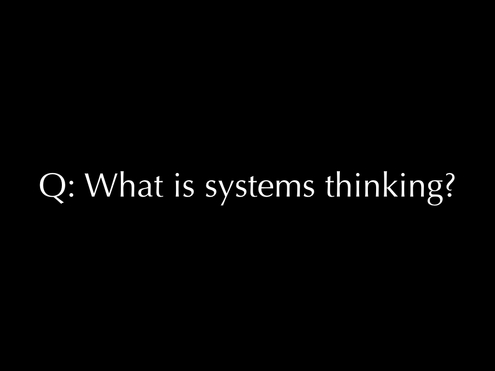
What is systems thinking?
I’d be willing to bet that in that brief moment of silence what went coursing through the corpuscles of your minds was any number of answers to this question. This is what we theorists refer to as pluralism—many possible answers. And, while it is true that there are many questions that have many possible answers I want to propose that pluralism makes an excellent brick with which to build walls, but a terrible foundation. Universality makes for a solid foundation
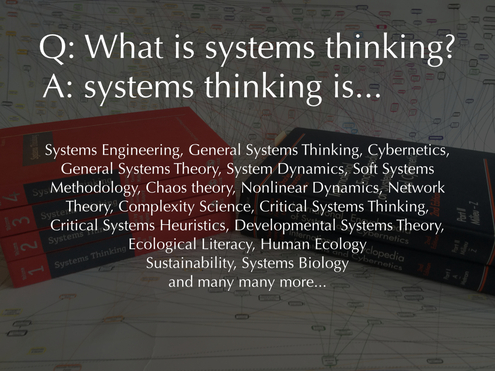
These are a few of the most popular answers to the question, “what is systems thinking?”…
Systems Engineering, General Systems Thinking, Cybernetics, General Systems Theory, System Dynamics, Soft Systems Methodology, Chaos theory, Nonlinear Dynamics, Network Theory, Complexity Science, Critical Systems Thinking, Critical Systems Heuristics, Developmental Systems Theory, Ecological Literacy, Human Ecology, Sustainability, Systems Biology, and many many more…
But the best, most complete, and most current answer to this question is this one.
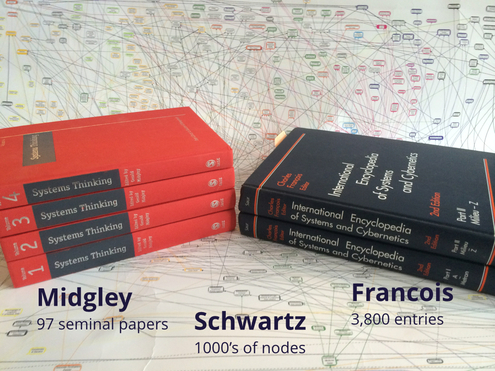
This is what I call the MFS universe of systems thinking, an acronym for Midgley, Francois, and Schwartz. Conceptually and theoretically speaking, it represents a relatively thorough literature review of the systems thinking concepts. It is an impressive and amazing contribution, the combination of which makes up all of the organisms, species, genus, and phyla of the systems thinking kingdom…
But, I am reminded of the field of biology prior to Darwin’s theories….a field which could have been described as a sophisticated form of stamp collecting, where biologists travelled the world stuffing specimens in jars, capturing life, as it were, but not really elucidating what it was about life that made it so..The great geneticist and evolutionary biologist Dobzhansky once remarked, "Nothing in biology makes sense except in the light of evolution.” As a field of study, Systems thinking desperately needs a universal theory to help us make sense of it all….
Fields of knowledge, like children, go through a natural maturation process. The mature program of physics was born as an awkward metaphysics until it found its way through modern theories from Newton to Einstein. The handsome devil that we see in chemistry today, was born as gangly alchemy. So too, systems thinking must find its rights of passage by discovering universal theoretical truths.
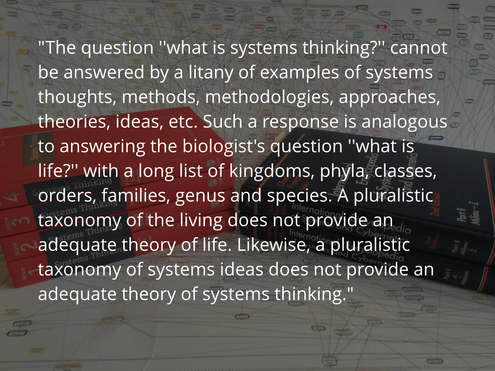
Let me share with you an analogy I have written and spoken about many times, "The question ''what is systems thinking?'' cannot be answered by a litany of examples of systems thoughts, methods, methodologies, approaches, theories, ideas, etc. Such a response is analogous to answering the biologist's question ''what is life?'' with a long list of kingdoms, phyla, classes, orders, families, genus and species. A pluralistic taxonomy of the living does not provide an adequate theory of life. Likewise, a pluralistic taxonomy of systems ideas does not provide an adequate theory of systems thinking."
Prior to Darwin’s theories, biologists made a good reputation and living for themselves “stamp collecting” the world’s specimens. And while this gave us a pluralism of examples of life, it did not answer the most basic question, what are the fundamentals of life? Today, researchers at Santa Fe Institute are making headway in answering this universal question.
I propose that we should be moving in the same direction. What are the fundamentals of systems thinking? What are the universals. From this viewpoint, the question has a different answer…
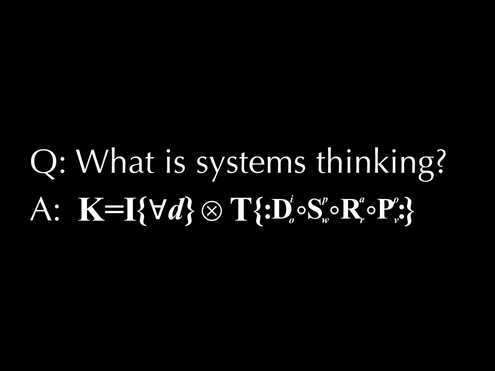
What is systems thinking?
The answer is a simple formula that describes the DSRP Theory.
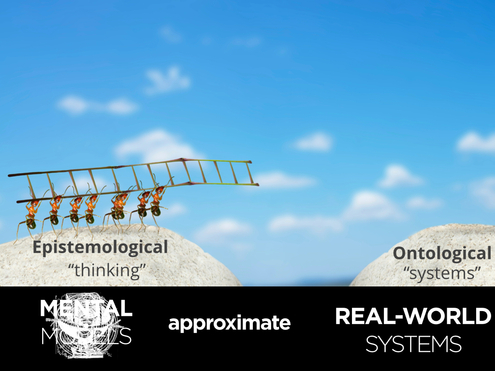
I’ve always contended that the secret to the systems thinking crisis can be found in its name. Systems thinking is about building a bridge between two worlds: the epistemological world of knowledge or thinking and the ontological world of reality or systems. And, we are the ants. We are the bridge builders.
This ontological world is full of these things we call systems. Real systems are existential abstractions, generalizable to a simple condition: their stuff appears together, works together, exists together.
The epistemological world is a world of mental model builders. Practitioners of thinking and builders of knowledge. From the very simplest childhood mental models to CERN’s advanced models of quantum physics, from the origin stories of the Bible to the planetary models of the heavens built by Kepler, Ptolemy, and Copernicus, these ideas have just one thing in common….
they are mental models attempting to approximate reality.
The origins of systems thinking were reactionary. A reaction to flawed but revered and foundational mental models that were misleading us in our approximations across all disciplines.
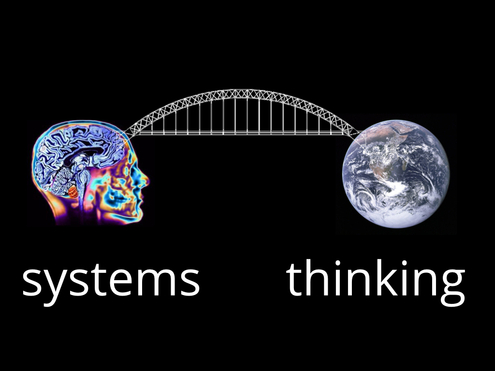
Because, if we were to discover a truly adequate bridge between real-world systems and the mental models of our minds, then the need for this thing we call systems thinking would crumble.
We would just call it thinking. Because thinking has always been an attempt to approximate systems in the real-world.
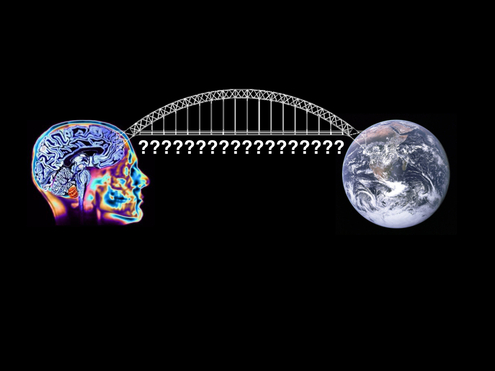
What would such a bridge look like?
It would need to be something that is held in common between physical reality and mental reality. It would need to apply to all things. Not just biological things but mental things. Not just neurons, but cells. And not merely cells, it would need to apply to atoms, molecules, and such.
A least common denominator for living and nonliving matter as well as for mental states.
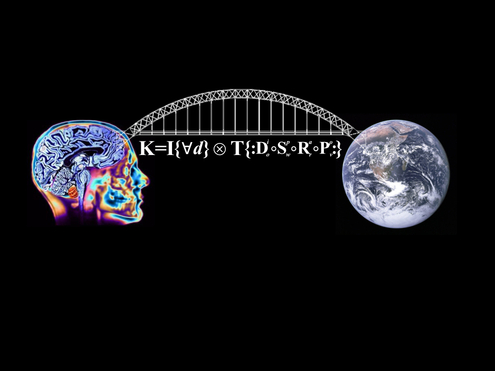
DSRP Theory is a bridge theory in three ways:
It bridges ontological systems and epistemological thinking and knowledge building.
It bridges the physical-chemical-biological worlds with the neurological-psychological-linguistic-social worlds
and it bridges systems thinking theory and systems thinking practice.
It shows that the Information, or data, that emerges from things is coded in a particular DSRP way and that our thinking can also decode this information.

Our minds are not a blank slate. We are imprinted with our evolutionary history. We are leftovers from a Big Bang. Born of the stardust of our universe.
Our minds are not blank slates but are stamped with the imprint of reality. Homegrown in the context of thing-ness, coherence, interrelationships and the perspectival position. We are woven of the same braid. We are programmed with the same code. This code is hidden to our conscious mind, occluded by the details, wrapped up in information, as we are preoccupied with direct experience. So, we don’t see it. But it is there. It is the code that gives reality structure and gives information meaning. It is the stuff of thought. Not merely of thought, the verb, the process of thinking about something, but of thought the noun, the structures that are left over when we are done thinking—knowledge.
When we think something we are bringing a little reality into existence. We are making approximations of reality. But, reality isn’t a passive bystander in the thought, it is a full partner. Reality is active, not inert. Reality gives us cues and if we pay attention we will see this structure. So, the meaning we make is not solely the product of our minds—we are not literally creating reality in our mind, we are co-creating an approximation of reality and our number one partner in crime... is reality itself.
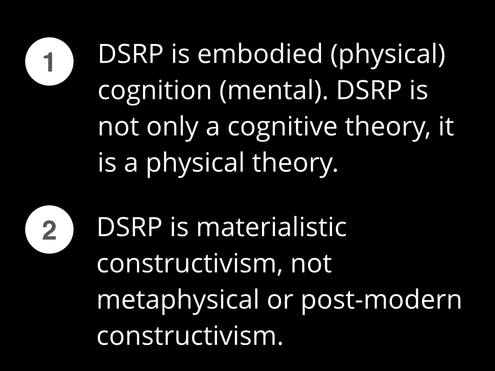
Many scholars have asked for clarification on the epistemological stance of DSRP Theory and the types of systems it applies to. Let me be clear:
First, DSRP is embodied cognition. It is not something that occurs only in our thoughts, but in our perceptions and gathering of sensory information. DSRP is pre-linguistic and pre-cognitive. DSRP is not simply a cognitive theory (a theory of the mind). It is a physical theory.
Second, DSRP is unapologetically materialistic. Although it can be misinterpreted as a form of post-modern constructivism, it is not, it is materialist constructivism. There is nothing meta-physical or metaphorical about DSRP.
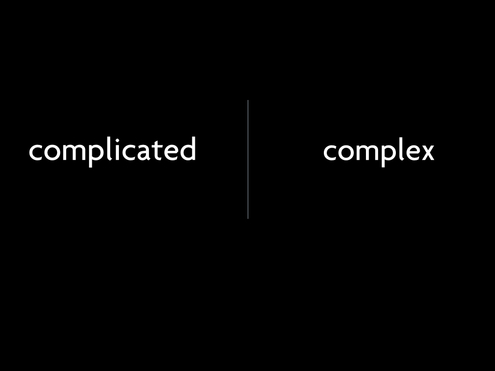
Okay. Now that we have covered the lighter fare…I’d like to describe the internal dynamics of this theory.
One of the primary misconceptions of DSRP Theory is how d,s,r,and p interact, or don’t. DSRP is often thought of as buckets by which to categorize or as a kind of checklist. While it is true that DSRP may offer a useful heuristic in this regard, it is a dynamical theory not intended as a merely a checklist or a categorical organizer.
In fact, dsrp are the simple rules of systems thinking, but let me take a moment to explicate exactly what I mean by that.
I think that we can all agree, a priori, that both Reality and the mind are complex systems.
But just in case, let me say that a complex system is the kind of stuff most of us care about and are interested in. Living stuff, mushy, wet stuff…adaptive stuff. Let me give you an example:
Kick a rock three times in the same way and the same thing happens each time. This is because rocks are not complex adaptive systems and the reaction is governed by Newtonian laws.The rock is a complicated system. It is not adapting.
But, kick a dog three times in the same way and something different happens each time. First, the dog circles away. Next kick, he growls. On the third kick, he bites. The dog is a complex system. He adapts. His reactions vary.
We know something important about complex systems. It turns out that contrary to popular thought, complex systems are not complicated underneath. They’re simple. That’s an important distinction that we must make, because we often confuse complicated and complex.
For over 2500 years, scientists have thought that complicated and complex were the same thing. In the last 50 years we realized we got it wrong...
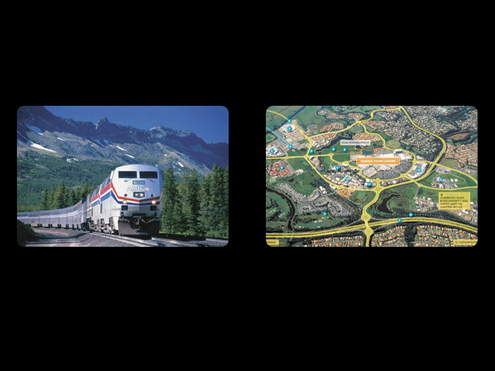
Which do you think is more complex, a railroad or road network?
Many of you might choose the railway. But the answer is that a road network is more complex. Here’s why: if you travel to work by train, and the track has been cut, that’s pretty much it. Everything downstream from the place where the track is cut is unreachable. There’s not much you can do but wait.
On the other hand, if you use the road network to get to work and one day there is an accident that close down an intersection on your normal route, you and the other commuters simply adjust. You adapt by taking a different route.
Let’s try one more.

Which is more complex, bird or Boeing?
A Boeing jet is certainly the epitome of complicated, from its lithium ion batteries to its flight systems.
The bird, on the other hand is relatively complex. Let’s see why….

(Watch video here)
Take a look at the flocking behavior of what amounts to millions of starlings. Look at how quickly millions of birds pivot from all moving left, to all moving right. There’s simply not enough time for some type of communication to occur between the leader birds and the follower birds. There’s not even enough time for the signal to spread never mind for it to be understood. These types of systems--which we see in flocks, schools of fish, traffic patterns, ant colonies and across the spectrum of nature and human society--baffled scientists for years because it was unclear how the behavior was being coordinated by the leaders in the system.
It turns out, there were no leaders! Only followers. So what’s causing this remarkable, adaptive, and complex behavior?
Simple, local, rules...
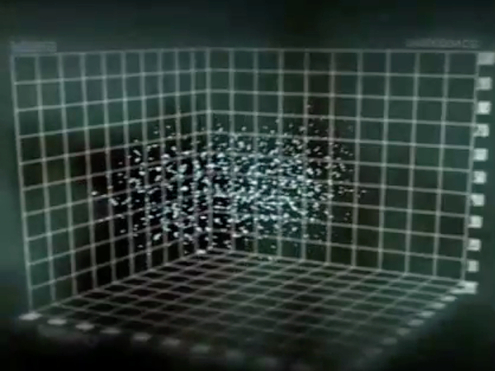
Ian Cousins did a simulation to show exactly what rules these flocks were following and found just three:
maintain distance x (locally to nearest neighbors)
adjust direction (locally to nearest neighbors)
avoid prey
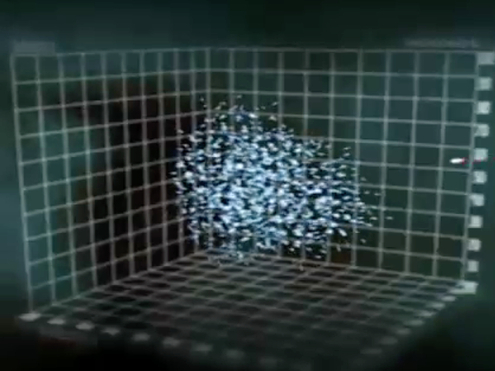
That’s it. No prescient leader necessary. No global awareness. Local awareness of just the neighbors.
You can actually see perturbations of these rules as the rule moves through the system.

Yet, despite the simplicity and locality of these rules a kind of “superorganism” emerges from dynamics of autonomous agents and simple local rules.
We can learn a lot about complex organization and systems from the experts...who are termites, ants, birds, and fish...nature. Nature has had more time in the lab.

It turns out that complicated systems are complicated through and through…Do you remember the Boeing 787 Dreamliner, touted as one of the most amazing planes in the world? It was shut down by a complicated battery malfunction. Not terribly adaptive.
In contrast, complex systems are based on simple rules underneath.
There lies the difference. The idea that simplicity and complexity are intertwined is, well, simple, yet sublime.

(Watch video here)
Of course we can see these complex systems all around us, as we are agents in them ourselves. In the classic stadium wave, the rule is simple: stand up when the person to your left stands up.
A simple local rule where no single leader has a global vision, yet up to 70,000 people can collectively behave as a single blanket superorganism.
Knowing that all complex systems have simple rules underneath helps us to discover what makes these systems behave the way they do.
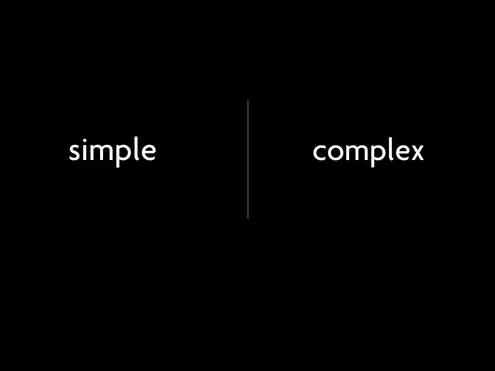
We often think of simple and complex as opposites. Yet, the etymology of the words simplex and complex share a common root “-plek”.
Nobel laureate and founding member of the Santa Fe Institute for the study of complex systems, Murray Gell-Mann wrote, “It is important to connect with both simplicity and complexity. What is most exciting about our work is that it illuminates the chain of connections between, on the one hand, the simple underlying laws that govern the behavior of all matter in the universe and, on the other hand, the complex fabric that we see around us, exhibiting diversity, individuality, and evolution. The interplay between simplicity and complexity is the heart of our subject.”
The complexities of the mind as it tries to accurately portray its existence in the universe is no different. Thinking is complex? Yes. Taken as a whole, the diversity of human thought is bewilderingly adaptive, personal and complex. Even our thoughts from minute to minute can seem incomprehensibly complex. So, naturally, we assume that there must be a complicated explanation. The truth is, naturally, there is a simple explanation.
Simple rules that underlie the complexities of systemic thinking.
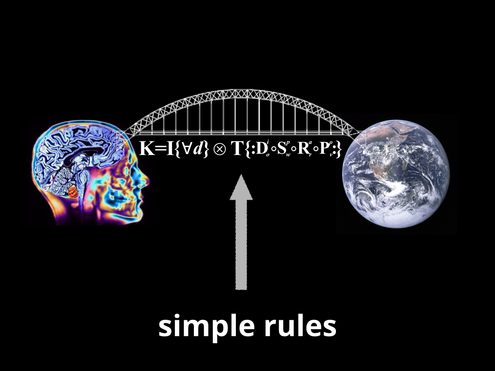
That’s what the DSRP equation describes…the simple rules that the mind follows to create more and more accurate approximations of reality. It describes how information or data is encoded or structured by four cognitive processes in order to create knowledge or mental models.
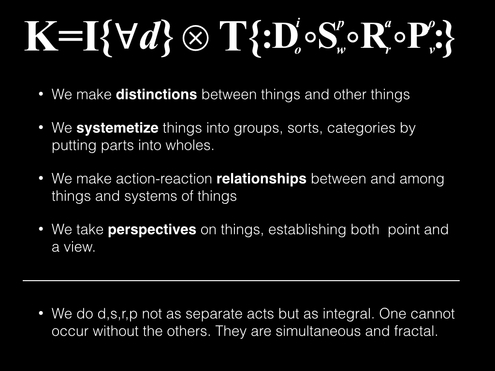
We make distinctions between things and other things, by creating a boundary between identity and other
We systematize things into groups, sorts, categories by putting parts into wholes.
We make action-reaction relationships between and among things and systems of things
We take perspectives on things, establishing both point and a view.
We do d,s,r, and p not as separate acts but as integral. One cannot occur without the others. They are simultaneous and fractal.
Let’s briefly look at each one in concept before we look at the mathematical formalism.
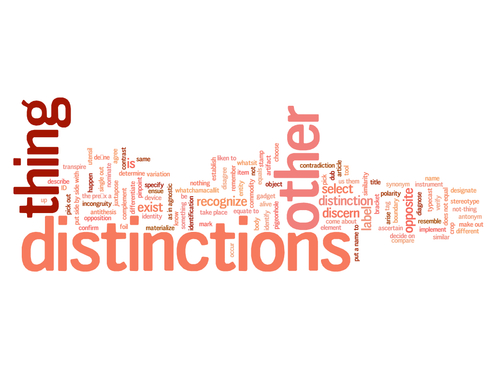
Making distinctions between and among ideas: How we draw or define the boundaries of an idea or a system of ideas is an essential aspect of understanding them. Whenever we draw a boundary to define a system's identity, that same boundary defines what is not the system ("other"). Any boundary we make is a distinction between two fundamentally important elements: the identity of the system, and the other stuff that is not the system. When we understand that all thoughts are comprised of distinct boundaries we become aware that we focus on one thing at the expense of other things. Distinction making allows us to simplify our thinking,, yet it also introduces biases that may go unchecked when unaware. It is distinction making that allows us to "retrieve a coffee mug" when asked, but it is also distinction making that creates us/them concepts that lead to closed mindedness or worse alienation or even violence. Distinctions are a part of every thought-act or speech-act, as we do not form words without having formed distinctions first.
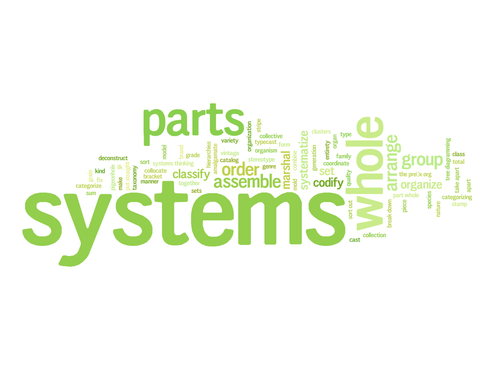
Organizing ideas into systems of parts and wholes: Every thing or idea is a system because it contains parts. Every book contains paragraphs that contain words with letters and letters are made up of ink strokes which are comprised of pixels made up of atoms. To construct or deconstruct meaning is to organize different ideas into part-whole configurations. A change in the way the ideas are organized leads to a change in the meaning itself. Every system can become a part of some larger system. The process of thinking about things means that we must draw a distinction where we stop zooming in, or zooming out. The act of thinking is defined by splitting things up or lumping ideas together. Nothing exists in isolation, but in systems of context. We can study the parts separated from the whole or the whole generalized from the parts, but in order to gain understanding of any system, we must do both in the end.
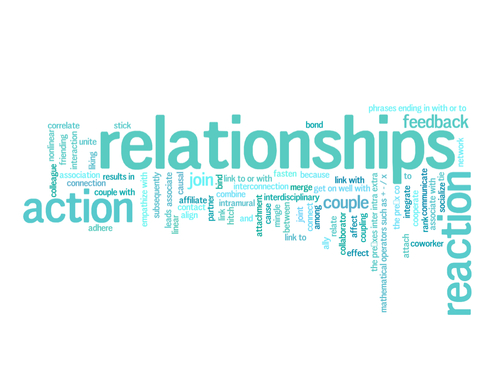
Identifying relationships between and among ideas: We cannot understand much about any thing or idea or system of things or ideas without understanding the relationships between or among them. There are many important types of relationships: causal, correlative, feedback, inputs/outputs, influence, direct/indirect, etc. At the most fundamental level though, all types of relationships require that we consider two underlying elements: action and reaction, or the co-relating effects of two or more things. Gaining an awareness of the numerous interrelationships around us forms an ecological ethos that connects us in an infinite network of interactions. Action-reaction relationships are not merely important to understanding physical systems, but are an essential metacognitive trait for understanding human social dynamics and the essential interplay between our thoughts (cognition), feelings (emotion) and motivations (conation).
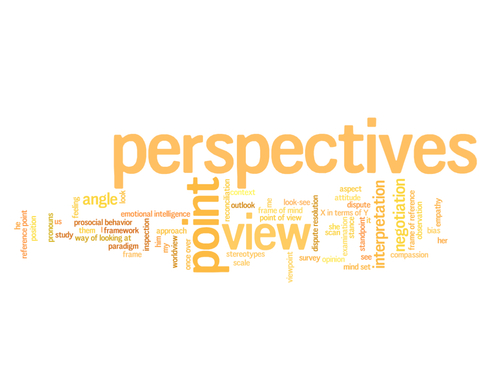
Looking at ideas from different perspectives: When we draw the boundaries of a system, or distinguish one relationship from another, we are always doing so from a particular perspective. Sometimes these perspectives are so basic and so unconscious we don't even see them, but they are always there. If we think about perspectives in a fundamental way, we can see that they are made up of two related elements: a point from which we are viewing and the thing or systems of things that are in the view. That's why perspectives are synonymous with a "point-of-view." Awareness of the value of taking perspective and being aware of the perspectives one takes (and equally important, does not take) is paramount to deeply understanding oneself and the world around us. There is a saying that, "If you change the way you look at things, the things you look at change." When we shift perspective, we also transform the distinctions, relationships, and systems that we see and do not see.
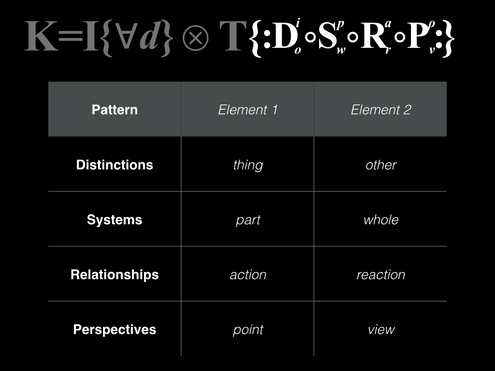
At the core of the DSRP Theory are the dynamics based on simple rules, internal dynamical properties and the four patterns, each having two elements.
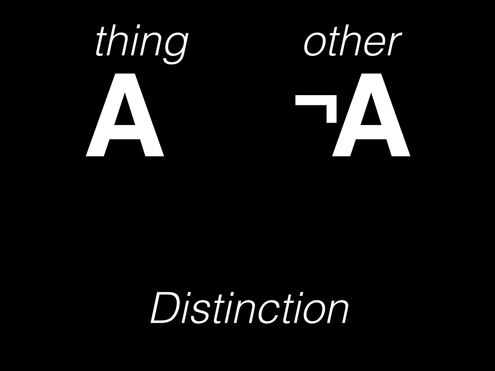
The best way to get a deeper understanding of the derivation of these patterns and elements is to look at how they are simultaneous and universal for any concept. That is, for any concept, the four patterns are necessary and sufficient.
Aristotle gave us the law of the excluded middle or that for any A that exists, there must exist not-A. Aristotle’s excluded middle concept illustrates the existential nature of a thing being dependent on other things which lies at the heart of the boundary condition that makes up all distinctions: the boundary between a thing or identity and the other or non-identity. In other words, Things exist but they do not exist in a vacuum. They exist in concert with other things. Distinction making is about drawing boundaries between things.
This simple but basic premise serves as the faulty basis for our systems of logic (such as true or false), our system of law (such as guilty/not-guilty), social constructs such as Us and them, and the binary code that runs all of our computers and electronics. It is the tyranny of Either-Or over the genius of And-Both. Aristotle taught us all bivalent thinking, when reality is multivalent. While the universe has always existed in an infinite array of hues, Aristotle taught us all to see only black or white.
Aristotle wasn’t wrong about A and not-A, but he wasn’t entirely right either. He didn’t go far enough, which has unfortunately led to 2500 years of excluding the middle that exists between A and not-A, through bivalent logic and countless thinking errors…
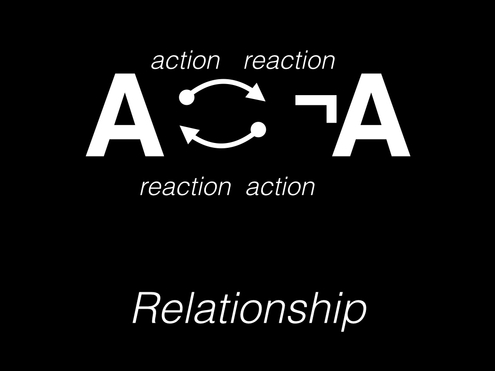
If the existence of A implies the existence of not-A, then the reverse is also true. This means that A and not-A are implicitly related because for every A that exists it has an A-like effect on not-A and vice versa. We can think of this as a mutually reinforcing feedback loop. The more A-like A becomes, the more contrasted is not-A and vice versa. Action and reaction relationships, the basis of Newton’s Third law.
Notice that these action-reaction relationships occur as the result of things existing. You need nothing more than existence for stuff to begin relating to each other.
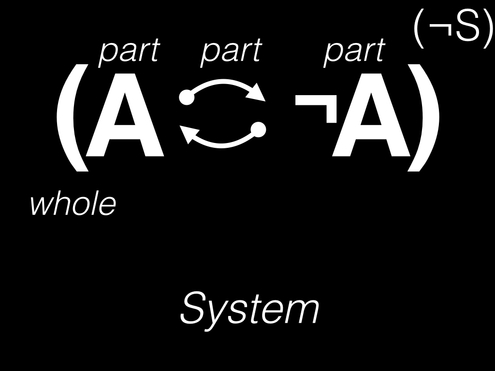
Whenever you have two things that relate in some way, you have by definition, a system of the simplest form because they must co-exist in order to co-relate. Therefore, this assembly can be describes as a whole with various parts belonging to it. Notice the relationships are also parts of the whole, a misconception we make often in the system thinking world that has profound implications that I won’t divulge herein in the interest of time. Suffice to say, there are some subtle things going on here that have enormous implications for the field of systems thinking.
We can also see that this new system, let’s call it S, is a new distinction between S and not-S. Ad infinitum.
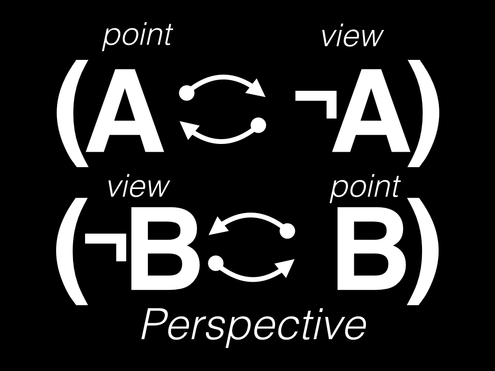
Finally, let us revisit Aristotle’s A and not-A. Let us take a slightly different starting point with an identity we will call B. Now B is the proper name for what was called not-A in the previous scenario. Starting with B, we can see that for B to exist, not-B must exist. From this new point of view, we can see that what previously was known as A is not-B. What we have shown is that the existence of A and not-A is purely perspectival because we could look at it from a very different perspective.
The realization that the bivalent logic of Aristotle has actually had perspective hidden within it all along reveals the possibility of a multivalent logic. Logic that is perspectival, relativistic, and sees an infinite number of black and white distinctions. In other words, logic that is paradoxical. And, contrary to what many have claimed, mathematics is not the language of nature. The language of nature is paradox.
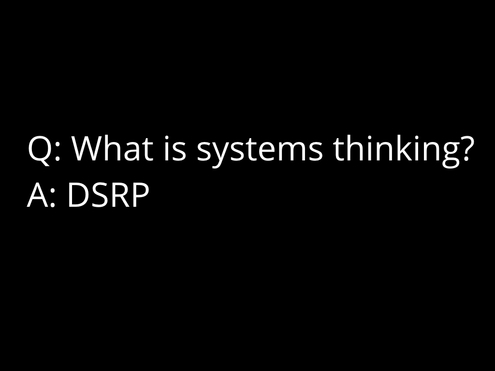
So, let’s return to our question. What is systems thinking?
Answer, DSRP.
There are of course many variations of systems thinking and many instantiations that are special in nature. The Midgley, Francois, Schwartz “universe” of systems concepts details these. But universal to all of these concepts and theories is dsrp and its dynamical properties.
To think systemically is to recognize that underlying the complexity of systems and the complexity of thought is a simple underlying pattern of distinctions, systems, relationships and perspectives. These repeating patterns are simple, but their fractal and recombinant dynamics can be bewilderingly complex. Being aware of the hidden patterns in our thinking--that is, being metacognitive--not only tells us what systems thinking is, but also reveals how to “do it.”
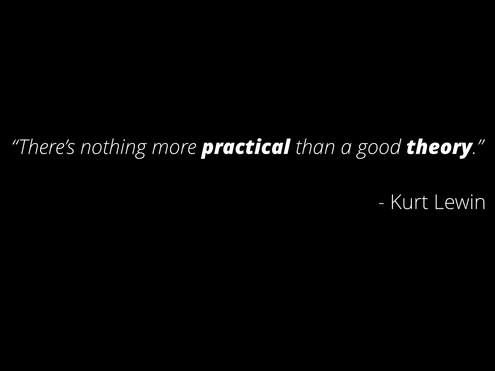
The eminent social scientist, Kurt Lewin said, “There’s nothing more practical than a good theory.”
Physicist and polymath, Richard Feynman, said it in a different way, “It doesn't matter how beautiful your theory is, it doesn't matter how smart you are. If it doesn't agree with experiment, it's wrong.”
I couldn’t agree with them more. I’ve never affiliated with the separation of theory and practice because theory is practice and practice is theory. A theory that fails in practice isn’t a theory, its wrong. And practice that isn’t informed by theory is the random fiddling of a fool.
So, I want to move on from the inner workings of DSRP theory and focus on DSRP as a bridge of theory and practice.
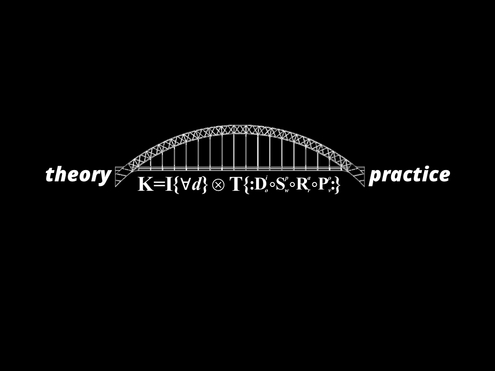
In practice, systems thinking belongs to the people… it needs to be democratized by increasing public understanding of it.
While the origins of systems thinking began with a frustration with the enduring paradigms of the scientific norm, its future must have democratic aspirations. Because for systems thinking to truly work, all people need to better approximate reality, not just scientists with their controlled experiments but every citizen with their daily experiments. Systems thinking can, and will push the envelope on the most bleeding edge discoveries in science, but it also helps a Sharon, a Mitch, or a Bob raise better kids, learn algebra, develop an ethical internal compass, or dig a ditch in their backyard.
I’ll never forget a moment during my graduate studies at Santa Fe Institute in a bar in Santa Fe. A colleague and I were discussing systems thinking and two people were at the bar who asked us what we were so emphatically chatting about. We told them, expecting quickly to be dismissed as science nerds and to my great surprise, they both began talking about how they had heard of it before and wanted to use it but couldn’t figure out what it was. Their burning question: What is systems thinking? How do we do it?
It was at that moment that my fate was sealed. I knew that my work would be bridge building. Between theory and practice.
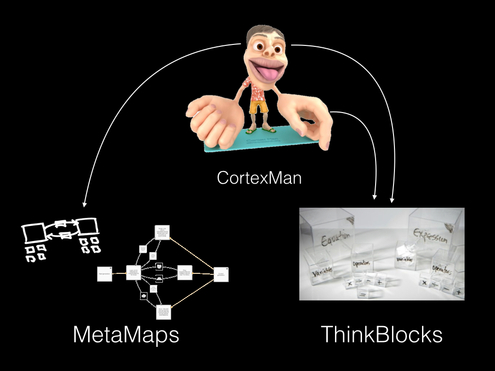
As faculty at Cornell University, I taught an advanced course in systems thinking for doctoral students from across the disciplines: mathematics, nonlinear systems, physics, engineering, hotel management, education, human ecology, business, etc.
I invented two tools that I called ThinkBlocks and MetaMaps, to help students conceptualize and to physically and visually model their dissertation topics. These tools are practical analogs of the DSRP theory in 2D drawings and 3D model building.
Why start with visual and tactile modeling? Because if we want to speak the language of the mind, we must understand its circuitry. Cortical homunculus, or Cortex Man as I call him, is research that shows how the brain’s neurons are hooked up to the body. As you can see, the primary conduits of the brain are the eyes and the hands. So, visual diagramming and tactile manipulation are one of the primary ways the mind learns.
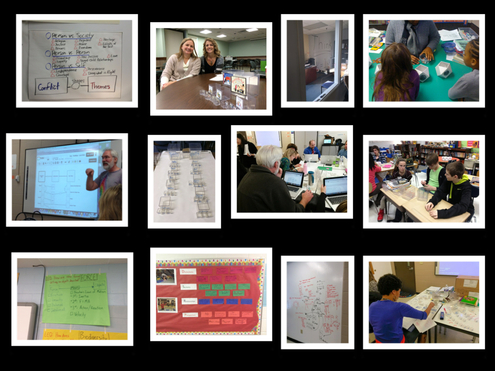
One of the things I am proudest of is that those plastic blocks and visual diagrams are today used by PreK kids and throughout the school years PreK to PhD. It has been amazing to see four and six year olds learn the same systems thinking concepts that I taught to doctoral students in the Ivy League. In addition, in our work with hundreds of thousands of students Prek to 12th grade, systems thinking isn’t something students are learning in a one-off course, its something they are using everyday to learn everything, across all subjects.
DSRP provides the simple rules (and tools and technology) that allow us to be metacognitive. Aware. So we can choose to be systems thinkers…
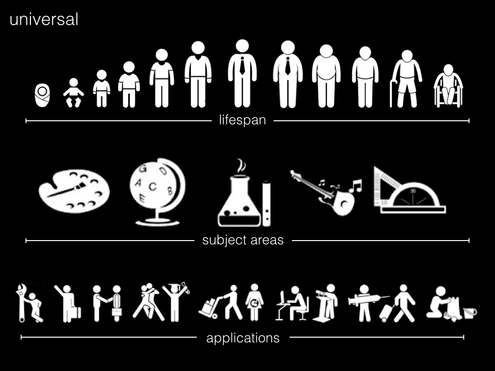
Beyond the school years, these tools and techniques are used in business and industry as well as by scientists. They are universal across the lifespan, across subject areas, and across applications.
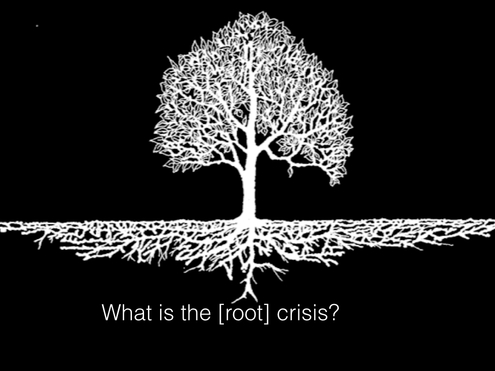
My colleagues and I surveyed the faculty of Cornell University to identify how scientists from different disciplines thought about the most pressing crises facing humanity. Respondents brainstormed 116 diverse crises, sorted, and ranked them in terms of importance and solvability. We applied multidimensional scaling and cluster analysis to their answers to the simple question, “What is the crisis?”
“Climate change and its effect on ecosystems” was ranked #1 in importance whereas the crisis ranked most solvable was, “loss of civil liberties in the US under the guise of fighting terrorism”. The only crisis ranked in the top ten for both importance and solvability was “shortage of potable and clean water”. Interestingly, the most i mportant and pressing problems on the list were also the least solvable and the most solvable were also the least important.
At the conclusion of the study, I found myself wondering: Is there a “meta-crisis” that lay at the root of all of these varied crises? Was there a single “root crisis”?
The field of research called “systems thinking” was born of a similar question. Problems are not divorced from the way we think about them. Gregory Bateson said it this way, “The major problems in the world are the result of the difference between how nature works and the way people think.”
The root crises—the one that lies underneath all of the crises humanity faces is a crisis of thinking.
There is a crisis that we in this room face and we owe it to the general public to solve it. The crisis we face is not just the lack of construct validity of systems thinking, but also the absence of an adequate theory of systems thinking that is equally practical. Without clarity on our part, we can hardly expect public understanding of systems thinking to increase.
Systems thinking can move scientific pursuit to new understandings, and it can move our daily human pursuits to a more systemic way of living. In other words, we (in this room) are responsible for both relaying the theoretical tenets of systems thinking, and to act on the moral imperative we share to increase public understanding of it… this will lead to everyone in society being a systems thinker. And, as we know, that has an enormous effect on our society... and our future abilities to adapt, problem-solve, and interact with one another.
Thank you.
Dr. Derek Cabrera’s Plenary for 58th Meeting of the International Society for the Systems Sciences at the School of Business at George Washington University, Washington DC, July 27 through August 1, 2014. The conference theme was: Learning Across Boundaries: Exploring the Variety of Systemic Theory and Practice
.png?width=150&height=150&name=CRL%20GOAT%20Logo%20(4).png)
